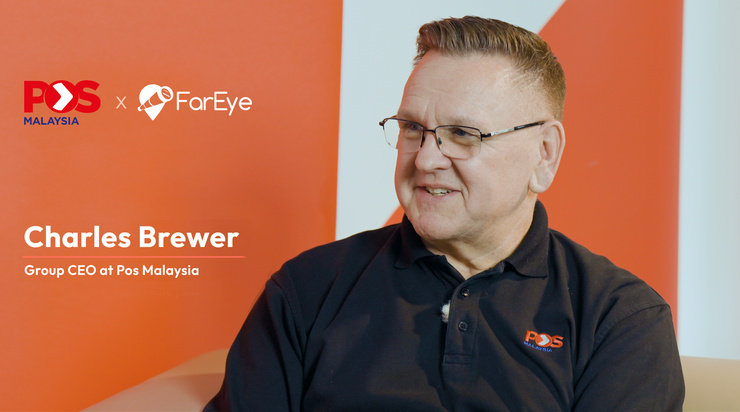- Logistics
Wholesale Logistics: Optimizing Primary & Secondary Distribution
Table of Contents
- What is Wholesale Distribution and Wholesale logistics?
- Primary Distribution: Supplier to Distribution Centers
- Secondary Distribution: Distribution Centers to Retailers
- Optimizing End-to-End Distribution Fulfillment
- Why Choose FarEye for Your Distribution Needs
- Future-Ready Distribution with Predictive Intelligence
- The Future of Wholesale Logistics
- FAQs on FarEye’s Distribution Solutions

Delays in primary distribution often come down to poor scheduling or missed dispatch windows. When that happens, stock gets held up, warehouses start to overflow, and secondary distribution struggles to meet delivery deadlines. Eventually, customers feel the impact through late shipments. Especially in bulk shipping, these delays can compound rapidly and affect large volumes of goods as well as downstream partners.
Wholesale logistics solves this by ensuring that both primary and secondary distribution operate in a well-coordinated, time-bound flow. It is not about moving goods faster but about moving them reliably at every stage, from supplier to shelf, across partners, transport modes, and geographies.
This article explores how wholesale logistics reinforces the distribution chain and why timing is the key to consistent performance.
What is Wholesale Distribution and Wholesale logistics?
Wholesale distribution is the process of purchasing goods in bulk from manufacturers and supplying them to retailers or other businesses within the distribution chain.
Wholesale logistics is the planning and execution of physical flow of goods that support wholesale distribution. It plays a crucial role in areas such as warehousing, inventory handling, scheduling and bulk shipping.
So wholesale logistics is basically the operational backbone of wholesale distribution.
Primary Distribution: Supplier to Distribution Centers
Primary distribution moves goods in bulk from suppliers to distribution centers. It sets the pace for downstream fulfillment, yet remains prone to delays, stock mismatches, and poor coordination across modes.
Understanding the Role of Primary Distribution
Primary distribution moves goods in planned bulk from suppliers to distribution hubs. It affects when inventory becomes available for picking, packing, and outbound movement. Delays at this stage often create warehouse backlogs and uneven downstream flow.
- Converts purchase orders into scheduled supplier shipments
- Supports load consolidation and route-level planning
- Enables faster throughput at distribution centers
Challenges in Managing High-Volume and Multi-Modal Shipments
- Slot Congestion at Docks: Overlapping arrivals delay unloading and stall onward dispatch.
- Uncoordinated Mode Shifts: Handovers between sea, rail, and road often miss timing windows.
- Fluctuating Load Commitments: Last-minute changes in carrier capacity disrupt planned volumes.
- Delayed Status Updates: Late transit alerts limit warehouse prep and strain staffing.
- Inconsistent Handling Standards: Mode-specific rules raise error rates in intake and sorting.
Real-Time Tracking for Primary Shipments
In primary distribution, delays often begin long before anyone notices. Without continuous updates tied to shipment milestones, teams fall behind while waiting for carrier status calls or scanning outdated logs. The longer that gap, the harder it gets to maintain pace downstream.
Live tracking connects route progress with on-ground readiness. It helps planners anticipate arrival times, adjust dock schedules, and act early if loads are running late. The result is less downtime, fewer missed slots, and a more predictable distribution rhythm.
Ensuring Compliance in Primary Distribution
Regulatory requirements shift between suppliers, regions, and product categories. But when primary shipments scale, compliance errors multiply especially in labeling, documentation, and carrier handoffs. These gaps can trigger costly audits or hold-ups at checkpoints.
Strong distribution compliance means your systems must flag issues before loading begins. That includes verifying transport certifications, validating product-level tags, and ensuring records match local transit rules. When done right, it keeps shipments audit-ready and friction-free from origin to dock.
Secondary Distribution: Distribution Centers to Retailers
Secondary distribution links warehouse operations with store-level availability. Its performance shapes how quickly goods move from stockrooms to shelves and how reliably retailers serve demand.
The Importance of Efficient Secondary Distribution
Secondary distribution is important because it bridges inventory flow between distribution centers and retail outlets. It determines how fast shelves get restocked, especially during peak or promotional cycles.
When this link runs efficiently, it reduces retail stockouts, prevents spoilage for perishables, and ensures product availability. In wholesale logistics, it’s where customer expectations and delivery performance intersect daily.
Key Challenges in Secondary Distribution
Secondary distribution faces real-time routing, scheduling, and delivery window challenges in high-volume retail logistics.
- Fragmented Retailer Requirements: Different retailers demand varied delivery windows, formats, and compliance checks per shipment.
- Inconsistent Route Execution: Route adherence drops due to dynamic urban conditions and uncoordinated dispatch priorities.
- Inventory-Shelf Mismatch: Lack of precise ETAs causes stock to arrive either too late or before needed.
- Unpredictable Last-Mile Conditions: Traffic restrictions, loading delays, and entry protocols create recurring fulfillment disruptions.
Achieving Unified Visibility Across Retail Deliveries
Retail deliveries still rely on fragmented systems and make it hard to track what’s en route. When teams juggle separate dashboards and carrier portals, visibility in secondary distribution becomes reactive instead of real-time.
Unified tracking links shipment status, location, and delivery events across all carriers. It helps your team to catch exceptions early, confirm drop-offs faster, and sync retail inventory with arrival schedules.
Leveraging IoT and Geo-fencing in Secondary Distribution
IoT sensors and geo-fencing tools are responsible for tracking shipments to store-level arrivals. It connects your systems and sends continuous updates on cargo conditions, truck locations, and their estimated arrival.
And, geo-fencing triggers instant alerts when trucks reach certain regions or deviate from routes. It helps your team to adjust loading schedules, allocate dock space, and manage store inventory precisely.
Optimizing End-to-End Distribution Fulfillment
Every step in logistics wholesale needs to align with demand, from supplier intake to retail drop-off. Gaps in flow often create lags, missed slots, and higher rehandling risk in wholesale logistics.
Here’s how seamless orchestration supports end‑to‑end fulfillment:
Coordinating Logistics from First-mile to Last-mile
You can’t treat the first-mile and last-mile as separate lanes. When coordination breaks between suppliers, distribution hubs, and retail points, the delays ripple fast. The only way to keep it steady is by anchoring everyone to the same movement plan: timing, loads, and updates synced before anything rolls out.
Demand-Driven Scheduling and Planning
Wholesale logistics works best when demand patterns drive the movement. When shipments are scheduled based on shelf pull or regional buying behavior, vehicles move fuller, and replenishments arrive closer to actual need. It helps you reduce holding costs, empty runs, and warehouse congestion without compromising store readiness.
Improving OTIF (On-Time, In-Full) Metrics
You’re measured on how consistently orders arrive complete and on time. That means your supply timelines, distribution cadence, and delivery commitments must stay tightly synced. Wholesale logistics helps you coordinate upstream planning with last-mile readiness, so every delivery meets OTIF targets without manual chasing or end-point compromises.
Why Choose FarEye for Your Distribution Needs
Wholesale logistics requires more than disconnected systems and rigid planning. To ensure smooth distribution from source to shelf, businesses need real-time visibility, coordinated workflows, and the ability to adapt quickly at every stage. FarEye enables enterprises to connect and optimize each leg of the journey, including the last mile, by unifying operations, tracking performance, and driving reliable, on-time deliveries at scale.
Here’s what sets the platform apart:
Unified Platform for Complete Logistics Orchestration
You manage fewer errors when planning, execution, and delivery run on one system. It connects every leg: supplier handoffs, warehouse dispatches, retail drops, so you don’t chase scattered updates or miss service windows. That alignment helps your teams act faster and fix issues early, without toggling across disconnected tools.
Seamless Integration with ERP, WMS, and TMS Solutions
Wholesale logistics workflows depend on how well systems talk to each other. With FarEye, integration isn’t a long IT project. Prebuilt APIs and connectors allow fast linking with ERP, WMS, and TMS platforms already in place. That keeps distribution data flowing across order, inventory, and delivery functions without creating bottlenecks.
Proven Results: Enhanced Visibility, Reduced Costs
With wholesale logistics, teams that maintain visibility across the supply chain manage performance and cost together. When delivery milestones are tied to real-time updates, delays are flagged early and corrective actions come faster.
- One Greece-based courier leader saw a 50% drop in operational costs, achieved 92% delivery accuracy, and a reduction of WISMO inquiries by 60%.
- A Southeast Asian cold-chain provider gained 100% real-time shipment visibility and recorded 99.3% successful deliveries across key routes.
Future-Ready Distribution with Predictive Intelligence
Predictive intelligence in wholesale logistics uses data models to anticipate order volumes, adjust dispatch plans, and reduce delivery risks. It improves decision-making across distribution, from inventory movement to route scheduling and resource allocation.
Here’s how it delivers measurable results:
AI-Powered Inventory-driven Dispatch
AI-powered dispatch aligns inventory movement with shifting demand signals. You can route shipments based on warehouse availability, avoid stockouts, and balance distribution loads in real time. It reduces idle miles and ensures inventory reaches the right node before demand spikes.
ML-enabled Proactive Exception Handling
Machine learning helps anticipate missed scans, delays, or temperature breaches across your distribution flow. It flags issues before they break service-level thresholds, letting your teams adjust routes, shift loads, or notify partners instantly. With exception patterns learned over time, response windows tighten and delivery accuracy improves.
Achieving Sustainability through Load Optimization
Load optimization in wholesale logistics starts with aligning shipment volumes, vehicle types, and delivery slots. Predictive systems model this balance daily, helping planners reduce partial loads and avoid excess trips. This steady efficiency reduces fuel use and maintains delivery timelines without straining margins.
The Future of Wholesale Logistics
Wholesale logistics now runs on real-time signals, not delayed reports. You need systems that track inventory, monitor movement, and adjust dispatching based on what’s happening across the network. That’s how teams avoid pileups, late arrivals, and wasted capacity.
To make this level of coordination repeatable at scale, you need a central system to drive it. FarEye fits into this role as a control tower for logistics execution. It supports your team with consistent planning, shipment visibility, and dependable last-mile delivery. If you're scaling wholesale logistics, this orchestration gives you the clarity and control to move forward with confidence.
See how FarEye’s solutions can optimize your wholesale logistics for greater efficiency and compliance. Book Your Demo Now
FAQs on FarEye’s Distribution Solutions
What Is Wholesale Logistics?
Wholesale logistics is how goods move in bulk from manufacturers to storage hubs or retail outlets. It involves moving, storing, and handing off products without delays. The goal of wholesale logistics is to keep stock available where it’s needed, without letting anything pile up or run out
How Does FarEye Manage Primary and Secondary Distribution Windows?
FarEye manages primary and secondary distribution by aligning each handoff in the chain. From supplier dispatch to warehouse intake and retail drop-offs, every leg stays coordinated through real-time updates.
You don’t wait for a call to check your status. The system shows where shipments are, what’s delayed, and how routes are being adjusted on the fly.
Can FarEye Centrally Manage Multiple Logistics Routes?
Yes, FarEye can centrally manage multiple logistics routes by giving your team one place to plan, assign, and track movement. Each route, whether regional or long-haul, runs on a shared view of real-time orders and traffic. That keeps everyone, from warehouse ops to fleet leads, on the same page.
How Does FarEye Integrate With ERP/Order Management Systems?
FarEye plugs into your ERP or order system using real-time APIs and built-in connectors. It pulls order, delivery, and stock data exactly when needed, so your teams don’t have to dig through systems or wait for updates.
Once connected, your teams stop switching tabs just to track progress. Everything flows into one view, from dispatch planning to customer updates, keeping operations steady and focused.
Does FarEye Support Bulk Returns And Reverse Logistics?
Yes, FarEye supports bulk returns and reverse logistics without relying on manual steps or siloed tools. You can track, process, and resolve bulk returns across locations using custom workflows tied to product type, return reason, and region.
It also lets teams automate return labels, schedule pickups, and handle exceptions with fewer touchpoints. That way, returns don’t clog up operations or create delays at sorting hubs.

Komal Puri is a seasoned professional in the logistics and supply chain industry. As the AVP of Marketing and a subject matter expert at FarEye, she has been instrumental in shaping the industry narrative for the past decade. Her expertise and insights have earned her numerous awards and recognition. Komal’s writings reflect her deep understanding of the industry, offering valuable insights and thought leadership.
Let's Talk to Our Experts and Optimize Your Deliveries Today!
An expert from our team will reach out within 24 hours
Related resources


